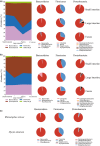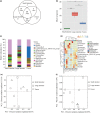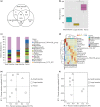Gut microbial diversity in two insectivorous bats: Insights into the effect of different sampling sources
- PMID: 29971963
- PMCID: PMC6530527
- DOI: 10.1002/mbo3.670
Gut microbial diversity in two insectivorous bats: Insights into the effect of different sampling sources
Abstract
The gut microbiota is now known as a key factor in mammalian physiology and health. Our understanding of the gut microbial communities and their effects on ecology and evolution of their hosts is extremely limited in bats which represent the second largest mammalian order. In the current study, gut microbiota of three sampling sources (small intestine, large intestine, and feces) were characterized in two sympatric and insectivorous bats (Rhinolophus sinicus and Myotis altarium) by high-throughput sequencing of the V3-V4 region of the 16S rRNA gene. Combining with published studies, this work reveals that Gammaproteobacteria may be a dominant class in the whole Chiroptera and Fusobacteria is less observed in bats although it has been proven to be dominant in other mammals. Our results reveal that the sampling source influences alpha diversity of the microbial community in both studied species although no significant variations of beta diversity were observed, which support that fecal samples cannot be used as a proxy of the microbiota in other gut regions in wild animals.
Keywords: Myotis altarium; Rhinolophus sinicus; 16S rRNA; gut microbiota.
© 2018 The Authors. MicrobiologyOpen published by John Wiley & Sons Ltd.
Conflict of interest statement
None declared.
Figures





Similar articles
-
The role of host traits and geography in shaping the gut microbiome of insectivorous bats.mSphere. 2024 Apr 23;9(4):e0008724. doi: 10.1128/msphere.00087-24. Epub 2024 Mar 21. mSphere. 2024. PMID: 38509042 Free PMC article.
-
A Faithful Gut: Core Features of Gastrointestinal Microbiota of Long-Distance Migratory Bats Remain Stable despite Dietary Shifts Driving Differences in Specific Bacterial Taxa.Microbiol Spectr. 2021 Dec 22;9(3):e0152521. doi: 10.1128/Spectrum.01525-21. Epub 2021 Nov 24. Microbiol Spectr. 2021. PMID: 34817279 Free PMC article.
-
Culture-dependent and metagenomic analysis of lesser horseshoe bats' gut microbiome revealing unique bacterial diversity and signatures of potential human pathogens.Microb Pathog. 2019 Dec;137:103675. doi: 10.1016/j.micpath.2019.103675. Epub 2019 Aug 29. Microb Pathog. 2019. PMID: 31473248 Free PMC article.
-
Bats Are an Untapped System for Understanding Microbiome Evolution in Mammals.mSphere. 2018 Sep 19;3(5):e00397-18. doi: 10.1128/mSphere.00397-18. mSphere. 2018. PMID: 30232167 Free PMC article. Review.
-
Creating an atlas to visualize the biodiversity of the mammalian gut microbiota.Curr Opin Biotechnol. 2022 Feb;73:28-33. doi: 10.1016/j.copbio.2021.06.028. Epub 2021 Jul 16. Curr Opin Biotechnol. 2022. PMID: 34280701 Review.
Cited by
-
Comparative Analysis of the Gut Microbiota of Bat Species with Different Feeding Habits.Biology (Basel). 2024 May 22;13(6):363. doi: 10.3390/biology13060363. Biology (Basel). 2024. PMID: 38927243 Free PMC article.
-
The fecal microbiota of the mouse-eared bat (Myotis velifer) with new records of microbial taxa for bats.PLoS One. 2024 Dec 5;19(12):e0314847. doi: 10.1371/journal.pone.0314847. eCollection 2024. PLoS One. 2024. PMID: 39637086 Free PMC article.
-
Diversity pattern and antibiotic activity of microbial communities inhabiting a karst cave from Costa Rica.Microbiology (Reading). 2024 Nov;170(11):001513. doi: 10.1099/mic.0.001513. Microbiology (Reading). 2024. PMID: 39530301 Free PMC article.
-
Smart capsules for sensing and sampling the gut: status, challenges and prospects.Gut. 2023 Dec 7;73(1):186-202. doi: 10.1136/gutjnl-2023-329614. Gut. 2023. PMID: 37734912 Free PMC article. Review.
-
Do gastrointestinal microbiomes play a role in bats' unique viral hosting capacity?Trends Microbiol. 2022 Jul;30(7):632-642. doi: 10.1016/j.tim.2021.12.009. Epub 2022 Jan 13. Trends Microbiol. 2022. PMID: 35034797 Free PMC article. Review.
References
Publication types
MeSH terms
Substances
LinkOut - more resources
Full Text Sources
Other Literature Sources

